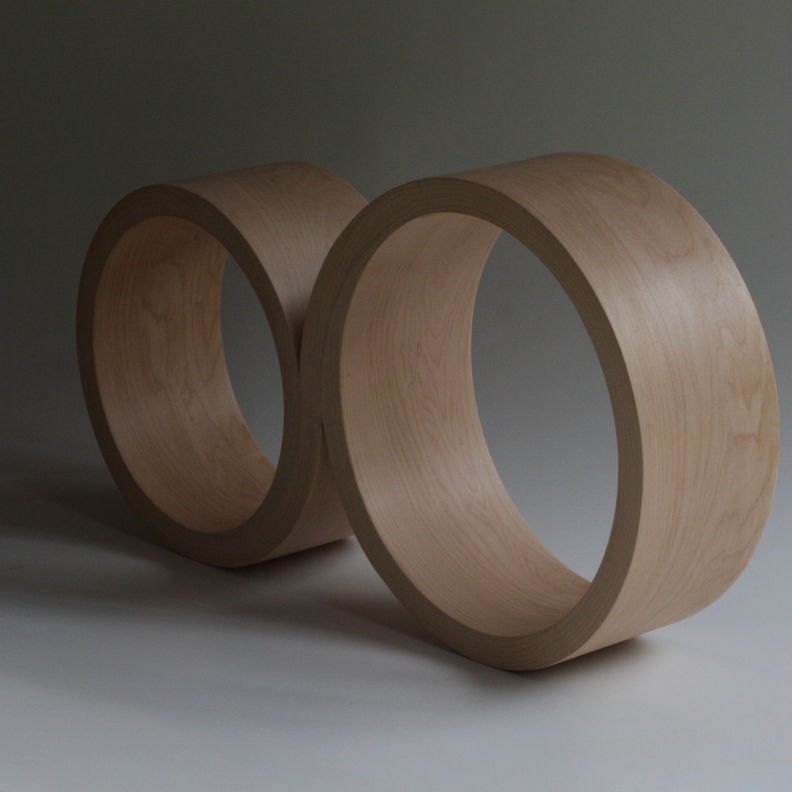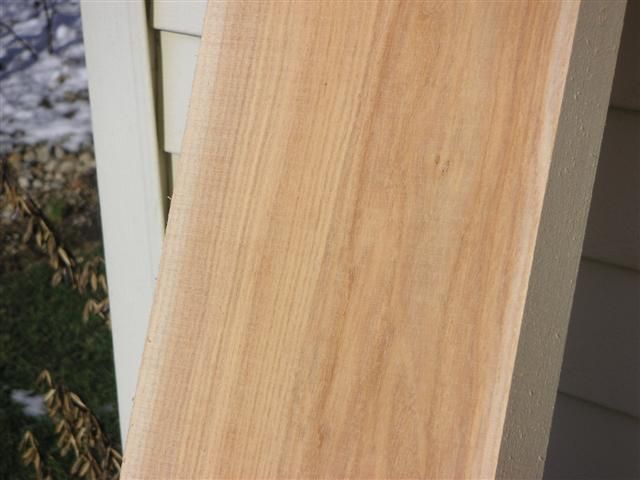Question
I am a luthier (I build stringed musical instruments) and I am concerned about the effects on wood structure from kiln drying versus air drying. Most luthiers prefer air dried and reference a change in the lignum during kiln drying, which makes the wood stiffer, more difficult to heat/steam bend, and potentially have more cracking. I do not know if they are referencing steam kiln drying or a dehumidification kiln. Does dehumidification kiln drying have less negative effects on the wood cell structure than steam kiln drying?
Forum Responses
(Sawing and Drying Forum)
From contributor T:
I'm not an expert by any stretch, or even a luthier. But I do have luthier customers and have been exposed to their varied likes and dislikes. I have sold kiln dried and air dried. I only sell air dried or green (3 of my regulars like to dry their own and request green) to luthiers now because I noticed the novice or beginner doesn't seem to reorder much.
In my layman's opinion, if a species is dried in a DH or vacuum kiln according to the well-established schedule for that specie, then any defects which are present are due to the growth characteristics or other external forces of the wood and the drying process itself does not add insult or injury to the cells compared to what air drying would do. Yes, wood can be dried too fast and caseharden, etc. and in my opinion, steam kilns can damage or at least alter wood cells in some species (i.e. walnut losing some color) but when properly dried in a DH or vacuum kiln, I do not see how the wood can be changed at the cellular level.
Moisture in wood weakens wood. So air dried wood which only reaches EMC is by its very nature (state of MC) going to be more pliable. KD wood right out of the box is 6% - 8% usually, so thin stock like that will probably be noticeably stiffer than air dried wood - not because the fibers have been altered (collapsed or honeycombed), but because the MC is considerably lower. Less moisture = more strength. For projects that can wait and you only have KD wood available, it will not take very long for the KD wood to reabsorb enough moisture to reach EMC and thus, you essentially have what is the equivalent of air dried wood. The bending properties would be the same as AD wood provided no defects occurred while kiln drying.
Luthiers are a picky lot to be sure, but I understand why. Tolerances are almost nil, and it is easy to think that unless the wood cells are as nature made them, the wood will not react consistently from build to build. I would submit that the noticeable difference from build to build, using the same species from different suppliers, is more than just MC. If you want consistency, buy 4/4 or better and resaw yourself. You will get consistent quality that way and have more control.
If you don't have the luxury of a good quality band saw, buy a moisture meter and only use the wood in a target MC% range per species. Now you have to decide what that range is because that too is a whole other discussion in your trade. The fact is, a build takes too long to be able to avoid reaching EMC and even if you could build one fast enough and get it sealed before that, I'm not sure it would be a good idea. A guitar is going to be exposed to about the widest range of environmental conditions possible over its lifetime, and an instrument which is inherently temperamental anyway needs to start life out at EMC anyway.
Don't forget, I have never built a guitar, so take all this for what it is worth.
I could see where perhaps the kiln drying process could rob some sound quality, but also think that it would be a very small effect. My observation is that there can be hundreds of aspects to a guitar that affect its sound - thickness of the top, heft and shape of the internal bracing, smoothness of the internal bracing, integrity of the neck to body connection, etc. I would wager that if the *only* difference between two guitars was that one used kiln dried material and the other used air dried material, the difference in sound might not be discernable to most ears. Of course, it would be impossible to have that as the only difference, because no two pieces of wood are identical, and growth rate, density, and grain pattern would be different on any two guitars (and those items are said to influence the tone as well).
Given a choice, I think air-dried would be a safer bet, but I also don't think I'd lose much sleep over whether the wood was kiln dried or not. I'd be far more concerned about the grain/characteristics of a particular piece of wood. Again, I claim no expertise at all... I'm just a player.
As an aside, there is also the idea of a guitar being "broken in." The discussion centers around this: the sound within the body of an acoustic causes the wood to move/vibrate, and until the guitar has been played for a substantial amount of time, the true tone of the guitar is not developed fully.
The luthier who works on my guitars has told me (and I'm not making this up), that when he finishes building a new acoustic, he will place it on a bench with a speaker directly over the sound hole and force feed the instrument sound/music for a day or two (in an area where he can't hear it). Now I'm not sure how much difference that would make, but that's the manic degree some folks get to when discussing guitars.
Also read once that there's a luthier in the south who has built guitars for Clapton, Cash - all the big name players - who sands the internal bracing up to 800 grit, claiming that the smoother the innards, the more sound can move around.
Would be interesting to blindfold someone who claims that KD lumber hurts the sound, and have them play 10 guitars, half made with KD lumber, and half with air dried, and see what percentage they bat when trying to identify the KD guitars.
In my opinion, what makes the biggest difference in a guitar's sound comes from the hands playing it. I've heard really expensive guitars sound awful in the hands of a weak player, and have heard marginal guitars sound amazing when played by a master. But it sure is amazing how beautiful the sound can be coming from a piece of spruce with a hole in it ;)
Here's a picture of a guitar that fella built for me... Electric, to be sure, but there are those who would contend the same KD issues apply for electrics as they do for acoustic. Me... I'm just hoping that some day I become a good enough player that I can blame the poor sound quality on the guitar, and not me.
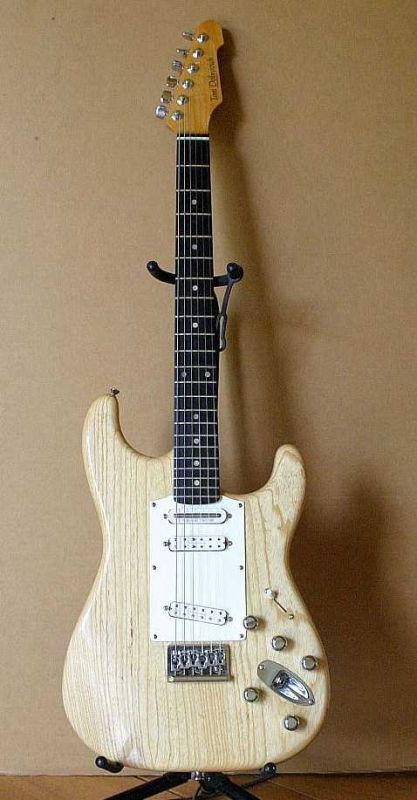
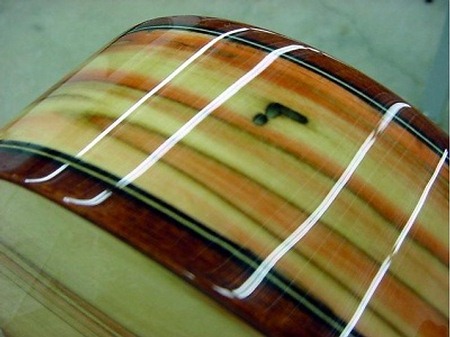
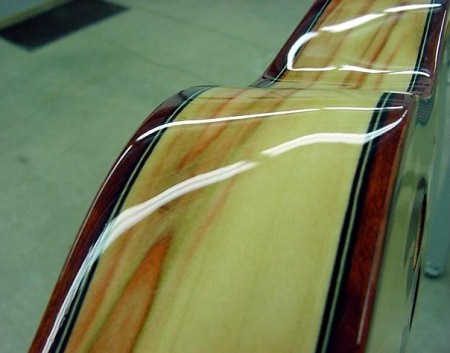
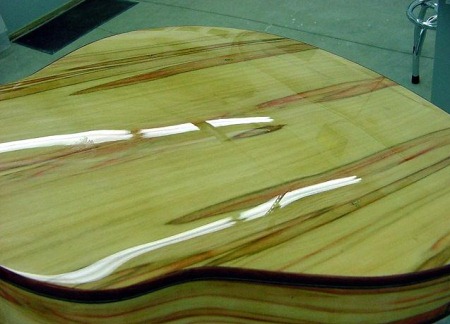
This makes one suspect it is the aging and relaxing of the wood after it has been put under some stress in the building processes, or a change in the cell structure of the internal sap or lignum in the wood. A drying or crystallization that creates a fuller tonal property. I am more interested in the differences of what happens to the sap or lignum during the various drying methods. I suspect there is much more involved than just water or moisture being eliminated.
I have heard the most amazing crap about what one must do to choose the correct wood. 99% is worthless drivel. The violin wood and varnish fetishists are the worst. (I do tentatively accept that some of the superior quality heard in old Strads, Amatis, etc., is due to the long term evaporation of volatile components of wood, leaving behind more or less crystalline residual material in the cell interiors. Haven't a clue if the effect, if actual, is altered by kiln drying of any type. I note that these classic violins may well be a school unto themselves. The instruments are altered substantially from the state that they left their maker's hand; they are very minimal structures carrying high bridge loads in a manner that uniquely stresses the wood and they are played heavily strung and at ever increasing pitch.
I suggest that you consider the following.
1) The most famous of the harpsichord building families are legendary for the lack of care they used in internal wood choice fit and finish. They made lots of them and if it didn't show they didn't bother... unless it mattered, and they knew what mattered. Their soundboards are legendary and the French for a century virtually gave up producing their own and just rebuilt Ruckers (expanding their compass), reusing the Ruckers soundboards (Grant O'Brien, "Ruckers - A Harpsichord Building Tradition"). Their cases were poplar, because it was available, cheap and would serve. The trick is in knowing what to do with the wood, and for the most part, not the wood. For example, you need strictly quartered soundboard wood on a harpsichord (although there are plenty that weren't) to control the seasonal expansion of what amounts to an only 1/8 inch thick piece of wood 36 inches wide. (More important now than then due to HVAC.) By the by, we artificially dry in a dehumidifier kiln soundboards so that when they are glued in they can swell, but not shrink... and crack.
2.) One dealer sells high alpine spruce gathered at the "correct" phase of the moon. The historic builders bought the wood that was available at the lumberyards of the time. The wood of commerce was usually bought in heavy timbers and taken to shops that specialized in sawing it down to usable sizes... But that phase of the moon stuff must sound great in advertising copy.
3. Robert Benedetto, in his book "Making an Archtop Guitar," has a picture of an excellent example of his work, which he states sounds correct, made exclusively out of lumber from a discarded pallet. (The fingerboard sports a lift truck inlay.)
4. Both myself and a friend who builds harps use air dried because we know a couple of fine fellows who cut wood and sell it at an excellent price and we have the space and time to let it dry. If we need something faster there is a local dehumidifer kiln owner who will fit our stuff in. If we need exotics we buy on the market and I have no idea how the stuff was dried.
4. The only test is the wood piece itself, however it got that way. Pick it up, hold it by a couple of fingers from one end and give it a sharp rap or two with your knuckles. It will tell you if it sounds like music wood. (It doesn't ring like a bell, or sound flabby like a mattress; it just has a good clean musical ring.)
Below is a photo of a plank of hard maple, 1 1/8" thick, x 6" x ~100" bent into a figure eight to create a new type of snare drum shell (twins). It is bent at 25% MC from air dried maple, then compressed end to end to bellows the cell walls, then bent and heat dried to de-stress the part and fix the shape. It has 10:1 scarf joints on each circle, roughly at the center bridge. Guitar sides are next.
